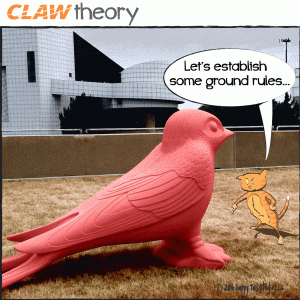Take It Outside!
The National Wildlife Federation (NWF) reports that on average kids across the U.S. spend half as much time outside compared to 20 years ago, so it may not surprise you to learn that estimates indicate kids spend more than seven hours in front of a screen a day. (WOW). That’s seven + hours of reasons to reconnect with the great outdoors…
The Cracking Art projects bring attention to this disconnection from nature with unique and engaging art installation “invasions” all over the world. Cracking Art’s playful and colorful oversized animals bring people outside, calling attention to the natural/unnatural distinctions with the plastic animal world made large. While the gap between humanity and the natural world “cracks” into an ever-widening gap, Cracking Art’s bright invitations to explore and pay attention to surroundings is a welcome gift to the landscape. Spot on to find Cracking Art “invasion” at Cleveland’s Great Lakes Science Center, where visitors are encouraged to stay curious!

Whether through structured learning activities, guided walks, stargazing, or simply playing, getting outside, especially with our children, has long term benefits. In addition to building a lasting interest in the environment, children who play outside have been found to be more physically active, more creative in play, less aggressive, and to demonstrate better concentration.
There is little doubt that there are countless results of living in a world that has become increasingly artificial. Emotionally, a sense of “disconnection” has been associated with a myriad of problems, ranging from depression to attention deficit disorder, while engagement with nature, on the other hand, has been linked to improved learning capacity and attention spans. Morally, it’s not difficult to imagine how disconnected feelings of alienation and isolation would fuel tendencies to constrict, rather than expand, one’s moral circle. Moving beyond paradigms that hold humans, animals, and nature in separate (often competing) spheres, understanding the complexity and interconnectedness of the natural world may promote a broadened sense of compassionate engagement. With a widened moral circle, perhaps one may move toward understanding “nature’s life as a precondition for human survival” (Vandana Shiva, Staying Alive).

